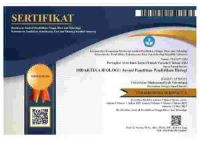PENGEMBANGAN MODUL BERBASIS REACT PADA MATERI JAMUR UNTUK MENINGKATKAN KEMAMPUAN BERPIKIR KRITIS SISWA KELAS X SMA
Abstract
Tujuan penelitian adalah menyusun karakteristik, menguji validitas dan menguji efektivitas modul berbasis Relating, Experiencing, Applying, Cooperating dan Transferring (REACT) pada materi Jamur untuk meningkatkan kemampuan berpikir kritis siswa kelas X SMA. Pengembangan modul berbasis REACT mengacu pada 9 langkah model research and development (R&D) dari Borg and Gall meliputi: penelitian dan pengumpulan data, perencanaan, pengembangan produk, uji coba produk awal, revisi produk I, uji coba lapangan, revisi produk II, uji coba lapangan operasional, dan revisi produk akhir. Analisis hasil penelitian menggunakan deskriptif kuantitatif dan kualitatif. Hasil penelitian menunjukkan: karakteristik modul dikembangkan berdasarkan sintaks model pembelajaran REACT yang bermuatan indikator-indikator kemampuan berpikir kritis; validitas modul siswa dinilai oleh penilaian ahli materi dengan 88,75%, ahli penyajian modul 93,44%, ahli keterbacaan 93,75%, dan ahli perangkat pembelajaran 92,40%; untuk modul guru dinilai oleh ahli materi dengan 94,40%, ahli penyajian modul 97,66%, ahli keterbacaan 93,75%, dan ahli perangkat pembelajaran 86,46%; rata-rata penilaian praktisi pendidikan 98,69%; serta rata-rata penilaian siswa 81,88%; modul berbasis REACT pada materi jamur efektif dalam memberdayakan kemampuan berpikir kritis siswa karena adanya perbedaan hasil posttest antara kelas modul dan kelas kontrol (Sig.=0,020 < a=0,05).
This research aimed to publish the characteristics and to test the validity and the effectiveness of module based on REACT to improve students’ critical thinking skills on fungal material at grade X. The development of module based on REACT referred to nine modified steps of Research and Development (R&D) model from Borg & Gall that included: research and information collection, planning, development of initial design of product, initial field test, first product revision, limited field test, second product revision, operational field test, and final product revision. The data analysis used qualitative and quantitative descriptive method. The research results showed that the characteristics of module based on REACT were developed according to syntax of REACT model that was included by indicators of critical thinking; the validity of student module was assessed by material expert at 88.75%, by module presentation expert at 93.44%, by readability expert at 93.75%, and by learning device expert at 92.40% and for the validity of teacher module was assessed by material expert at 94.40%, by module presentation expert at 97.66%, by readability expert at 93.75%, and by learning device expert at 86.46%; scoring average at 98.69% by practitioner and at 81.88% by students; and module based on REACT on fungal material was effective to improve students’ critical thinking skills because there was difference of posttest results between module class and control class (Sig.=0.020 < a=0.05).
Keywords
Full Text:
PDFReferences
Ali, K.L. (2005). Pengembangan Modul Biologi pada Materi Hakikat Biologi untuk meningkatkan Hasil Belajar Siswa Kelas X di SMA Negeri 8 Malang. Tesis, tidak dipublikasikan. PPS Universitas Negeri Malang.
Amri, S. & Ahmadi, I.K. (2010). Proses Pembelajaran Kreatif dan Inovatif dalam Kelas. Jakarta: PT Prestasi Pustakarya.
Borg, W.R. & Gall, M.D. (1983). Education Research: An Introduction (4th Edition). New York: Longman Inc.
Chick, H. & Watson, J. (2001). Data Representation and Interpretation by Primary School Student Working in Group. Mathematics Education Research Journal, 13 (2), 91-111.
Crawford, M.L. (2001). Teaching Contextually: Research, Rationale, and Techniques for Improving Students Motivation and Achievement in Mathematics and Science. Waco, Texas: CCI Publishing, Inc.
Fascione, P.A. (2013). Critical Thinking: What It Is and Why It Counts. California: California Academic Press.
Hazeli, Z. & Rezali, F. (2013). The Effect of Teaching Critical Thinking on Educational Achivement and Test Anxiety among Junior High School Student in Savech. European Online Journal of Natural and Social Sciences, 2 (2), 168-175.
Khatib, M. & Alizadeh, I. (2012). Critical Thinking Skill trough Literary and Non-Literary Text in English Classes. International Journal of Linguistic, 4 (4), 563-580.
Lunenburg, F.C. (2011). Critical Thinking and Constructivism Techniques for Improving Student Achievement. National Forum Teacher Education Journal, 21 (3), 1-9.
Mandernach, B.J., Forest, K.D., Babutzke, J.L., & Manker, L.R. (2009). The Role of Instructor Interactivity in Promoting Critical Thinking in Online and Face-to-Face Classrooms. MERLOT Journal of Online Learning and Teaching, 5 (1), 49-62.
Purwanto, R.A. & Lasmono, S. (2007). Pengembangan Modul. Jakarta: Depdiknas.
Ricketts, J.C. & Rudd, R. (2004). Critical Thinking Skills of FFA Leaders. Journal of Southern Agricultural Education Research, 54 (1), 7-20.
Rochaminah, S. (2008). Penggunaan Metode Penemuan untuk Meningkatkan Kemampuan Berpikir Kritis Matematis Mahasiswa Calon Guru. Disertasi, tidak dipublikasikan. SPs Universitas Pendidikan Indonesia, Bandung.
Rosana, D. (2012). Menggagas Pendidikan IPA yang Baik Terkait Esensial 21st Century Skills. Prosiding Seminar Nasional IV Pendidikan Sains yang Diselenggarakan Oleh FMIPA UNESA, 15 Desember 2012. Surabaya: FMIPA Universitas Negeri Surabaya.
Sadia, I.W. (2008). Model Pembelajaran yang Efektif untuk Meningkatkan Keterampilan Berpikir Kritis (Suatu Persepsi Guru). Jurnal Pendidikan dan Pengajaran UNDIKSHA, 41 (2), 219-237.
Savich, C. (2009). Improving Critical Thinking Skill in History. An Online Journal for Teacher Researcher, 11 (2), 1-12.
Schafersman, S.D. (1991). An Introduction to Critical Thinking. Diakses dari http://facultycenter.ischool.syr.edu/wp-content/uploads/2012/02/Critical-Thinking.pdf
Thomas, T. (2011). Developing First Year Student’s Critical Thinking Skills. Asian Social Science, 7 (4), 26-35.
Wu, H.K. & Hsieh, C.E. (2006). Developing Sixth Graders’ Inquiry Skills to Construct Explanations in Inquiry-based Learning Environments. International Journal of Science Education, 28 (11), 1289-1313.
Zimmerman, B.J. (2002). Becoming a Self-Regulated Learner: An Overview. Theory into Practice, 41 (2), 64-70.
Zumbrunn, S., Tadlock, J. & Roberts, E.D. 2011. Encouraging Self-regulated Learning in the Classroom: A Rieview of the Literature. Virginia: Metropolitan Educational Research Consortium (MERC), Virginia Commonwealth University.
DOI: https://doi.org/10.32502/dikbio.v1i1.957
Copyright (c) 2018 Didaktika Biologi: Jurnal Penelitian Pendidikan Biologi
Didaktika Biologi: Jurnal Penelitian Pendidikan Biologi is indexed by:

Didaktika Biologi: Jurnal Penelitian Pendidikan Biologi is licensed under a Creative Commons Attribution-ShareAlike 4.0 International License.







